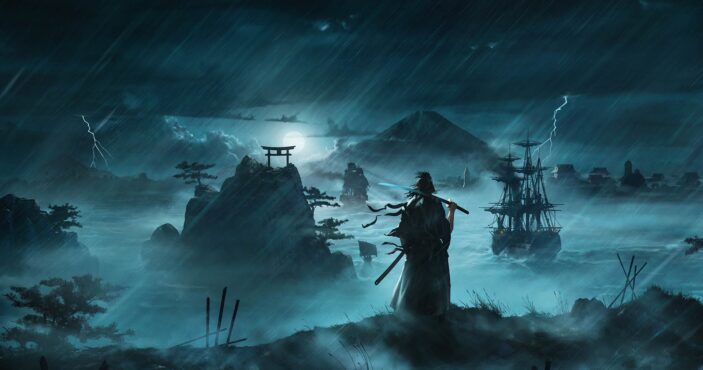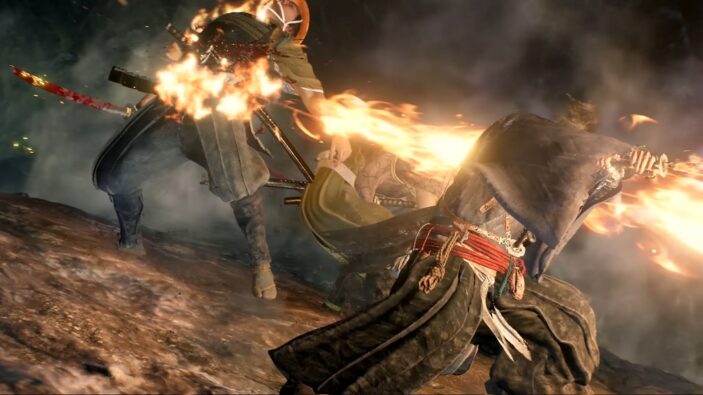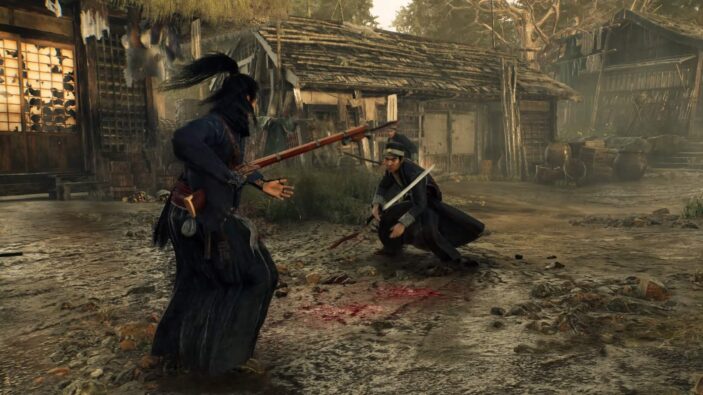
My past couple of weeks with Rise of the Ronin have left me feeling a little conflicted. I’ve been bouncing back and forth between the logic of my mind and the feeling of my heart. In many ways, this is a true cut above developer Team Ninja’s previous efforts with something like Nioh. Its combat is fantastic, as challenging and deep as you’ll find throughout the Soulslike genre. And just when I’m getting into its groove, it throws me into repetitive missions and flawed progression systems.
There’s certainly plenty to love here, and it’s actually a fantastic game for the most part, even if it feels obliged to throw in as many existing tropes and systems as possible. So buckle up for this one, it’s going to be a lengthy ride.
The Fate of a Nation
Set in Japan during the 19th century, Rise of the Ronin takes place during a historically interesting era, in which the country finally reopened its borders after numerous tumultuous wars. The story follows a pair of Blade Twins, who as children, survived a village massacre by Shogunate armies. You’ll get the chance to pick and create your own Ronin, with plenty of options to choose from.
All grown up, these Blade Twins have become skilled warriors, and have been tasked with sneaking aboard American Black Ships to assassinate Commodore Matthew Perry (we thought it too; there’s no relation to the late beloved Friends actor, but this was a real naval officer). As one of the twins is unfortunately killed, you soon embark on a tale of good old-fashioned revenge.

That being said, the story takes some larger turns later on, as you’ll come across various historical figures and side with or against the Shogunate armies to shape one of the most interesting eras in Japan’s history. It’s certainly well-paced and easy enough to follow, even if it tends to get caught in its grand sense of scale and purpose. Most of the voice acting is decent across the board, while the occasional civilian or NPC will belt out some cringeworthy lines now and again.
The general missions themselves are fun for the most part and initially present themselves with enough variety to get you through. You can take them on board by heading to certain areas of the map, and even come across them coincidentally as chance encounters out in the open world. Should these missions task you with breaking someone of importance out of an enemy camp or assassinating a particular target, the world feels much more lived-in when these encounters are found naturally.
You can also enter these encounters as set missions with up to two Blade Twins, in which your friends can also jump on board to control your allies via cooperative play. If you’re playing solo, you are also able to switch between any of these companions on the fly. Given these companions carry various weapons and utilise different fighting styles that are effective against certain enemy types it’s a welcome addition.

The only real gripe here is that even though Rise of the Ronin throws these exciting encounters at you throughout the story, it’s also expecting you to do them as side-quests, which tend to wear out their welcome if you’re looking to chip away at them throughout the narrative. I found it most entertaining to blaze through the meatier story, but I can’t lie and say it’s not taking away from the side content the game has to offer, which can hold its on unique rewards like weapons and clothing.
The Clash of Blades
The open world is fun enough to explore and some interesting smaller cities paint a version of Japan that’s transitioning out of its Feudal era. But no matter where you are, combat is well and truly king. Rise of the Ronin has taken the best parts from its predecessors and the genre alike, even if you’ve seen it all before. You’ll be able to merge light and heavy attacks with blocks and parries, while ranged weapons like rifles and pistols play a part when given the chance.
It’s also super tough, but not to the extent where it ever feels unfair. Like any other Soulslike game, there’s a level of challenge that presents itself through intricate timing and mastery of its mechanics, that begs understanding for the sake of progression. You’ll also be able to utilise several weapon types to get the job done, each with their own unique stats, special abilities and fighting styles to take advantage of against certain enemy types.

You’ll combine these styles and weapons to defeat your enemies and disrupt their Ki, a defensive meter that once broken, leaves enemies vulnerable to devastating attacks. You also have your own Ki meter to worry about as well, which has to be managed like a traditional stamina bar, which once empty, leaves you wide open. It’s consistently satisfying to mix up your two primary weapons and secondary ranged weapons, with a fatal finishing blow that comes once an enemy’s Ki meter is drained. Trust me, limbs will fly and heads will roll, and it’s absolutely brutal.
You’ll also have access to a Counterspark, a parry move that opens enemies up for a flurry of attacks. It can even be used to deflect incoming ranged attacks like arrows and gunshots. Mastering this is so important, as it feels rewarding when you pull it off, and punishing when you don’t. Enemies that kill you in combat can also kick off vendettas, which essentially encourage you to head back to them and finish the job, in order to gain back any Karma (XP) lost in battle.
The World Beyond
Combat feels great, and only deepens with its core upgrades. Strength, Dexterity, Charm, and Intellect all play a huge part in how you fight, talk and explore, each with their own separate skill trees. For example, levelling up your Charm tree helps with talking your way out of sticky situations, while the Dexterity tree allows you to land more critical hits with ranged weapons. Regular skill points can be gained by collecting Karma through combat, while rare skill points are gained only in certain situations, and can only be used to unlock specific abilities in certain skill trees.
Weapon upgrades, on the other hand, feel less impactful. Sure, they each bear their own stats, but as you’re generally finding a bunch of new weapons at every turn, you’ll never really feel the weight of your progression through these stats. Mastering the combat mechanics themselves feels so much more important that it makes these sub-systems feel a little useless at times. It’s way more interesting to strip down your core skill tree and reassign points for a new play style.

This level of customisation and replayability also extends to the Testament of Souls, a feature that once gained later in the story, allows you to go back to any point in time to replay missions. As a result, nothing ever feels lost to time, and you can even go back to make choices that retroactively change the story. As you progress, you’re consistently building bonds with certain characters based on your choices and interactions, and it’s great to see just how well these small changes work in time, as the story is set over several years.
As a result, this system unfortunately takes away from the novelty of the open world. With repetitive missions and enemies, the open world itself falls victim to the loot grind, as every enemy just seems to drop a bunch of rubbish, particularly in the latter hours. While there are ways to explore these vast open areas, including your trusty horse, a grappling hook for verticality and a glider that allows you to fly, it’s all a little disappointing when each of the map’s corners feels littered with the same enemy camps and loot.

When the story and combat feel as focused as it does in unison, you’ll end up relying on the Testament of Souls to live in those specific moments and interactions, instead of wanting to head out and explore. While I can respect Rise of the Ronin for going bigger at times, it really had something cooking when it felt more personal and linear.
To top it all off, it runs well enough on the PlayStation 5, targeting a solid 60 FPS. While it can drop in busier areas, it holds up for the most part. I feel that Ghost of Tsushima looks a little more polished than this overall, as some of the character models here are a little stiff, and the environment is a little drab and muddy. Don’t get me wrong, there are plenty of gorgeous areas to explore, but some of it feels like a missed opportunity as far as outright visuals are concerned.
Final Thoughts
There’s plenty to love in Rise of the Ronin, from its focused narrative to its satisfying combat system and core progression. Its linear course is engaging and draws you into its grand scale and sense of choice throughout.
But it’s only when Rise of the Ronin opens up that it begins to feel a little bloated in places that feel like they exist because this is what Team Ninja thinks an open world should be. I don’t feel as though they’ve completely fumbled here, as the experience is certainly enjoyable, but I feel as though they leaned less into what was working in its favour.
If you’re a fan of previous Team Ninja games like Nioh, or even the broader Souls genre, jump on board for the story and combat alone, as it’s one of the best examples out there.
THREE AND A HALF STARS (OUT OF FIVE)
Highlights: Engaging narrative and historical era; Deep and satisfying combat; Strong core progression systems
Lowlights: Bloated open world; Muddy weapon progression and upgrades
Developer: Team Ninja
Publisher: Sony Interactive Entertainment
Platforms: PlayStation 5
Available: Now
Review conducted on PlayStation 5 with a code provided by the publisher.
